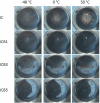Integrating bacterial cellulose in artisanal ice cream: a farm-to-fork sustainable approach
- PMID: 40957870
- PMCID: PMC12441127
- DOI: 10.1038/s41538-025-00536-2
Integrating bacterial cellulose in artisanal ice cream: a farm-to-fork sustainable approach
Abstract
This study explored the use of bacterial cellulose (BC) in milk-based cocoa ice cream as possible dietary fibers. BC fibers were added in 1%, 3%, and 5% wt. amounts, resulting in notable changes in texture, density, melting behavior. The ice cream transitioned from a Bingham to a Herschel-Bulkley fluid, while density rose with higher fiber content. Although hardness and gumminess slightly increased, the 5% wt. BC sample formed a more cohesive network structure when melted. Ice nucleation was delayed, with the first melt drop appearing later as BC content rose up to 22 minutes for the 5% wt. sample. Caloric content dropped by up to 21% corresponding to the highest amount of BC, making it a healthier dessert option. However, sensory testing showed that 1% and 3% wt. BC formulations were the most appealing to consumers.
© 2025. The Author(s).
Conflict of interest statement
Competing interests: The authors declare no competing interests.
Figures











References
-
- Clarke, C. The Science of Ice Cream. Royal Society of Chemistry: (2012).
-
- Adhikari, B. M., Truong, T., Prakash, S., Bansal, N. & Bhandari, B. Impact of incorporation of CO2 on the melting, texture and sensory attributes of soft-serve ice cream. Int. Dairy J.109, 104789 (2020).
-
- Liang, C. et al. Proteolytic treatment of waste dairy ice cream to accelerate milk fat separation. Int. Dairy J.145, 105702 (2023).
Grants and funding
- PN-IV-P7-7.1-PTE-2024-0305, no. 40PTE/2025/Unitatea Executiva pentru Finantarea Invatamantului Superior, a Cercetarii, Dezvoltarii si Inovarii
- PN-IV-P7-7.1-PTE-2024-0305, no. 40PTE/2025/Unitatea Executiva pentru Finantarea Invatamantului Superior, a Cercetarii, Dezvoltarii si Inovarii
- Project 2307 - μNanoEl, contract number 8N/03.01.2023/Romanian Ministry of Research, Innovation, and Digitization through the Core Program within the National Research, Development and Innovation Plan 2022-2027
- Project 2307 - μNanoEl, contract number 8N/03.01.2023/Romanian Ministry of Research, Innovation, and Digitization through the Core Program within the National Research, Development and Innovation Plan 2022-2027
- Project 2307 - μNanoEl, contract number 8N/03.01.2023/Romanian Ministry of Research, Innovation, and Digitization through the Core Program within the National Research, Development and Innovation Plan 2022-2027
LinkOut - more resources
Full Text Sources

